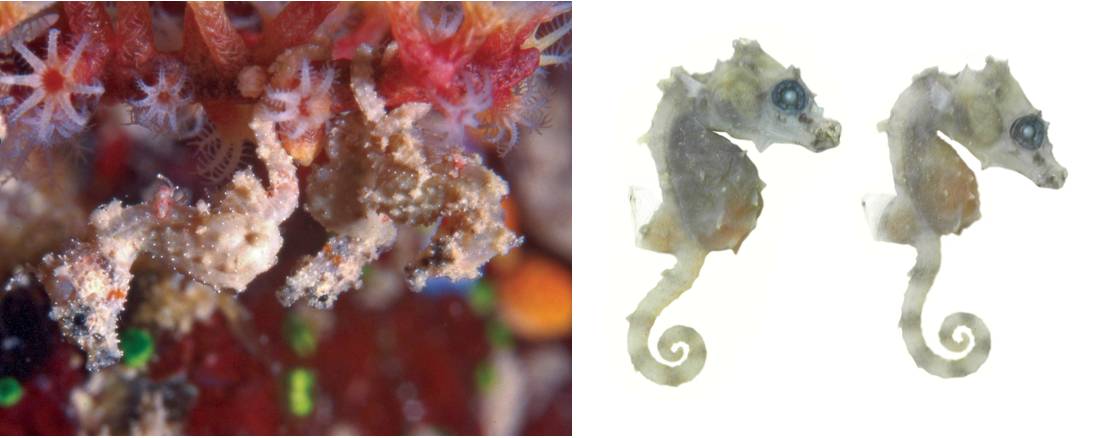The International Institute for Species Exploration at Arizona State University and an international committee of taxonomists – scientists responsible for species exploration and classification – today announce the top 10 new species for 2009, consisting of those described in 2008.
On the list are a pea-sized seahorse, caffeine-free coffee and bacteria that live in hairspray. The top 10 new species also include the very tiny (a snake just a slither longer than 4 inches or 104 millimeters), the very long (an insect from Malaysia with an overall length of 22.3 inches or 56.7 centimeters) the very old (a fossilized specimen of the oldest known live-bearing vertebrate) and the very twisted (a snail whose shell twists around four axes). Rounding out this year's list are a palm that flowers itself to death, a ghost slug from Wales and a deep blue damselfish.
Here they are in no particular order.
#10. Tahina spectabilis - A Palm that Flowers Itself to Death
Tahina spectabilis, growing at its only known site in western Madagascar. Photos courtesy of John Dransfield
Name: Tahina spectabilisCommon Name: Tahina Palm
Family: Arecaceae
How it made the Top 10: A gigantic new species and genus of palm with fewer than 100 individuals found only in a small area of northwestern Madagascar. This plant flowers itself to death, producing a huge, spectacular terminal inflorescence with countless flowers. After fruiting, the palm dies and collapses. The new genus is unrelated to any other of the 170 plus palms of Madagascar and is most closely related to 3 genera: one each in Afghanistan and neighboring parts of Asia; south Thailand; and Vietnam and southern China.
Soon after the publication of the species, seeds were disseminated throughout the palm grower community, raising money for it conservation by the local villagers, and it has become a highly prized ornamental.
Reference: Dransfield, J., M. Rakotoarinivo, W.J. Baker, R.P. Bayton, J.B. Fisher, J.W. Horn, B. Leroy&X. Metz. 2008. A new coryphoid palm genus from Madagascar. Botanical Journal of the Linnean Society 156: 79-91.Type Material: "Madagascar. Mahajanga, Analalava, Antsanifera, Antsingilava, 14°45′01″S, 47°25′53″E, altitude 9 m, 19.i.2007. Rakotoarinivo et al. RMJ337 (holotypus K; isotypi BH, MO, P, TAN)."
Type Locality: The Analalava district of northwestern Madagascar.Etymology: "Tahina – Malagasy for ‘blessed’ or ‘to be protected;’ also one of the given names of Anne-Tahina Metz, the daughter of the discoverer of the palm" and spectabilis from Latin, meaning notable or showy.
#9. Phobaeticus chani - Phantastic Phasmatid!
Photos by Philip Bragg
Name: Phobaeticus chaniCommon Name: None
Family: Phasmatidae
How it made the Top 10: This is the world's longest insect with a body length of 35.6cm (14 inches) and a overall length of 56.7 cm (22.3 inches).
Reference: Phobaeticus chani Bragg spec. nov. (p.138-141) in Hennemann, F.H.&V.O. Conle. 2008. Revision of Oriental Phasmatodea: The tribe Pharnaciini Günther, 1953, including the description of the world's longest insect, and a survey of the family Phasmatidae Gray, 1835 with keys to the subfamilies and tribes (Phasmatodea: "Anareolatae": Phasmatidae). Zootaxa 1906: 1-316.Type material: Holotype: "[female]&eggs (removed from body): Sabah, Penampang district, Ulu Moyog, c. 650 m, Native, 25.II.1989 (BMNH, ex coll. CLC)." Paratypes: "[female]: Sabah, Buntui, Sunsuron, J. Kulip, 10.X.1989 (FRSC)" and "[male]: Sabah, Sipitang, Coll. Yong Ah Lok, 15.IV.1983 (CLC)."
Etymology: "This new species, the longest known extant insect of the world, is named in honour of C.L. Chan (Kota Kinabalu, Sabah) [...]."
#8 Hippocampus satomiae - a pea-sized sea pony
 Color photo by John Sear; specimen photo by Rudie Kuiter
Color photo by John Sear; specimen photo by Rudie KuiterName: Hippocampus satomiae
Family: Syngnathidae
How it made the Top 10: This is the smallest known seahorse with a standard length of 13.8mm (0.54 inches) and an approximate height of 11.5mm (0.45 inches).
Reference: Lourie, S.A.&R.H. Kuiter. 2008. Three new pygmy seahorse species from Indonesia (Teleostei: Syngnathidae: Hippocampus). Zootaxa 1963: 54-68.
Type material: "Holotype: NMV A25420–001 (13.8 mm, male), Derawan Island, Kalimantan, Indonesia (02°17.690’N, 118°15.692’E), 10–18 m depth, on gorgonian Carijoa sp.? Muller 1867, October 2003, Satomi Onishi." "Paratype: NMV A25420–002 (13.4 mm, female), collection details as for holotype."
Type locality: Derawan Island off Kalimantan (Indonesian portion of Borneo).Etymology: This species name, satomiae, is "in honour of Miss Satomi Onishi, the dive guide who collected the type specimens."
#7 Leptotyphlops carlae - A Mere Thread of a Snake
 (The smallest snake, Leptotyphlops carlae, from Barbados) Copyright S. Blair Hedges
(The smallest snake, Leptotyphlops carlae, from Barbados) Copyright S. Blair Hedges
Common Name: Barbados Threadsnake
Family: Leptotyphlopidae
How did it make the Top 10: This is the world's smallest snake with a total length of 104mm (4.1 inches).
Reference: Hedges, S.B. 2008. At the lower size limit in snakes: two new species of threadsnakes (Squamata: Leptotyphlopidae: Leptotyphlops) from the Lesser Antilles. Zootaxa 1841: 1-30.Type material: "Holotype. USNM 564819, adult female, collected on 9 June 2006 under rock on ground near Bonwell, St. Joseph Parish, Barbados (Fig. 2A), 280 m (13° 11.196’ N, 59° 32.445’ W), by S. Blair Hedges and Carla Ann Hass. Field tag number 267708. Paratypes. USNM 564818, from same locality; BM 89.7.5.27, from Barbados (no specific locality); BM 1969.792, from Codrington College, St. John Parish, Barbados, 100 m (13° 10.543’ N, 59° 28.481’ W); California Academy of Sciences (CAS) 49279, “St. John, Antigua,” collected by W. K. Fisher in July, 1918, on the Barbados-Antigua Expedition. This locality is interpreted to be in error; it is likely from St. John Parish, Barbados" [see discussion in Hedges, S.B. (2008)].
Type locality: Bonwell, St. Joseph Parish, Barbados, Lesser Antilles.
Etymology: The species name, carlae, is dedicated to the author's wife, Carla Ann Hass.
Go on to part 2 with top new species 6-4.








Comments